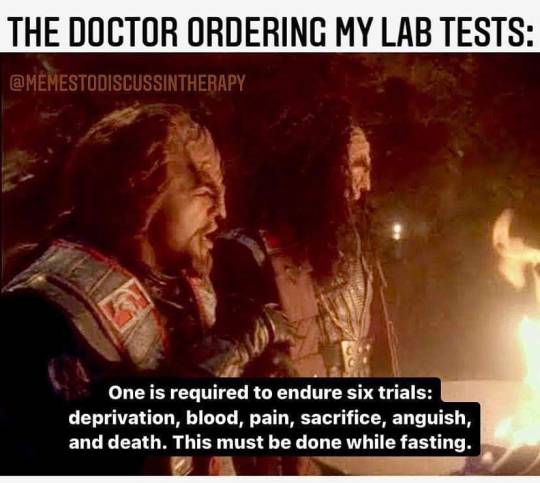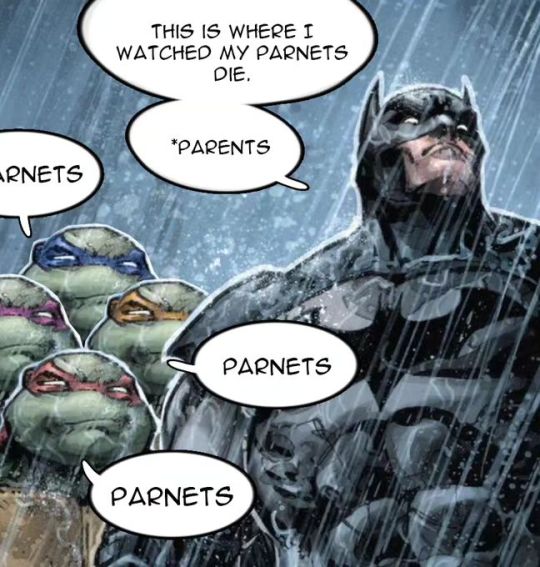Text
no thoughts only julian learning to knit and giving stuff to the ds9 crew
starting out with basic stuff like scarves and hats but eidetic memory would also be GREAT for memorizing lace charts so kira and jadzia get really intricate lace shawls
and honestly this works great as a fluffy gen kinda headcanon but also there is the shippy version
in which he is very nervous to give garak something because a) how would that be interpreted, would he think it’s weird and also b) garak is Very Good at textile crafts and probably would be able to spot any mistakes
but then garak offhandedly mentions that the station is Freezing Cold and julian gives him a hat and garak is totally shocked that a) julian can knit and also b) he would care enough that garak was cold to give him something handmade
he wears the hat all the time and it makes julian feel A Way lol
129 notes
·
View notes
Text
fantasy characters: “Geez”
me: who the fuck spread Christianity there
247K notes
·
View notes
Text
Kieran and Sean’s deaths hit me the absolute hardest. Sean’s was so sudden it made me ugly cry the entire time I was shooting people.




Favorite thing to do in the game was share a cup of coffee with Kieran.
184 notes
·
View notes
Text

Researchers Uncover Signal Needed for Blood-Brain Barrier
What makes the vital layer of protective cells around the brain and spinal cord — the blood-brain barrier — more or less permeable has been one of the more mystifying questions in neuroscience.
Understanding how the barrier works to allow in or keep out certain substances has critical implications for everything from disease progression to drug delivery.
Now, a new Harvard Medical School study, published in Developmental Cell, has brought scientists a step closer to figuring it out.
Working in zebrafish and mice, the team discovered that a signal originating from a gene in neurons is essential for the proper formation of the blood-brain barrier during embryonic development and helps ensure that the barrier remains intact throughout adulthood.
If replicated in further animal testing and eventually in humans, the findings could help scientists control the permeability of the blood-brain barrier. In doing so, researchers may be able to develop more effective ways of delivering cancer or psychiatric medicines into the brain and better strategies for combating barrier damage caused by neurodegeneration or stroke.
Following the science
The blood-brain barrier is made of tightly interlaced cells — endothelial cells, pericytes, and astrocytes — lining the blood vessels of the brain and spinal cord that make up the central nervous system. Together, these cells form a layered, semipermeable membrane that selectively lets in nutrients and small molecules, while keeping out harmful substances.
“In normal, day-to-day life, you need a blood-brain barrier to help protect you from invading toxins and pathogens in the blood,” explained lead author Natasha O’Brown, a research fellow in systems biology at HMS who is starting her lab at Rutgers University in September.
In the case of neurodegenerative diseases such as Alzheimer’s or Parkinson’s, or stroke, the barrier begins to break down, leaving the central nervous system susceptible to infection. On the flip side, the impermeability of the barrier presents an obstacle for delivering drugs to the brain.
For decades, scientists have known that the permeability of the blood-brain barrier is in part controlled by cells in the surrounding environment — known as the microenvironment. However, the genes in those nearby cells have largely remained a mystery.
Unbeknownst to the researchers, a major clue was swimming around inside fish tanks in the lab of senior author Sean Megason, professor of systems biology in the Blavatnik Institute at HMS.
O’Brown was studying a gene called mfsd2aa that, when mutated, causes the blood-brain barrier in zebrafish to become leaky throughout the entire brain. However, she noticed that some zebrafish had a barrier that was permeable in the forebrain and midbrain, but intact in the hindbrain.
“This observation led me down a rabbit hole of finding the gene that causes the blood-brain barrier to become regionally permeable,” she said.
A new character emerges
O’Brown conducted genetic screens on the zebrafish and discovered that the region-specific breakdown of the barrier was linked to a mutation in spock1 — a gene whose name brought to mind the Star Trek character but was otherwise unfamiliar to her.
In a series of experiments in zebrafish and mice, O’Brown confirmed that a spock1 mutation caused the blood-brain barrier to become permeable in some areas but not others. She also saw that spock1 was expressed in neurons throughout the retina, brain, and spinal cord, but not in the cells that make up the barrier itself.
In follow-up experiments, animals with a spock1 mutation had more vesicles — intercellular bubbles that can carry large molecules across the blood-brain barrier — in their endothelial cells. They also had a smaller basement membrane, a network of proteins found between endothelial cells and pericytes in the barrier. Cell-by-cell RNA analysis revealed that spock1 caused changes in gene expression in endothelial cells and pericytes in the blood-brain barrier, but not in other cell types in the brain. When O’Brown injected a dose ofhuman SPOCK1protein into zebrafish brains, it restored around 50 percent of blood-brain barrier function by repairing pericyte–endothelial cell interactions at a molecular level.
Based on these findings, the researchers concluded that the Spock1protein produced by neurons travels to the blood-brain barrier, where it initiates the proper formation of the barrier during development and helps maintain the barrier after.
“Spock1 is a potent secreted neural signal that is able to promote and induce barrier properties in these blood vessels; without it, you don’t get a functional blood-brain barrier,” O’Brown said. “It’s like a spark on a gas stove, providing a cue that tells the barrier program to turn on.”
Completing the picture
The study adds to a growing body of research by renowned blood-brain barrier biologist Chenghua Gu, professor of neurobiology at HMS, investigator at the Howard Hughes Medical Institute, and an author on the new paper. Her lab has been studying a cellular trafficking system that seems to regulate blood-brain barrier permeability through Mfsd2a, and exploring other aspects of the microenvironment that may be involved. Cumulatively, the work is providing scientists with an increasingly complete picture of how the blood-brain barrier functions.
Gaining this complete picture is essential as researchers attempt to manipulate the permeability of the barrier. For drug delivery, they often want to make the barrier more permeable, so therapies known to be effective for cancer or psychiatric disorders can reach the brain and do their jobs. For neurodegenerative diseases such as Parkinson’s and Alzheimer’s or situations like stroke, scientists want to counter the associated deterioration of the blood-brain barrier that makes the central nervous system vulnerable to external assaults.
O’Brown noted that spock1 is an especially appealing target for controlling the properties of the blood-brain barrier because it is conserved in humans and seems to act as a high-level regulator of barrier cells during development.
She now wants to explore how different lineages of pericytes in the barrier are differentially affected by spock1 signaling. She would also like to test out stroke models, to see if administering spock1 can counter a stroke’s effects on the blood-brain barrier.
“This isn’t the first neural signal scientists have found, but it is the first signal from neurons that specifically seems to regulate barrier properties,” O’Brown said. “I think this makes it a potent tool to try and toggle the switch.”
(Image caption: When researchers injected fluorescent dye (blue) into the circulatory system of a zebrafish with a spock1 mutation, the dye leaked out of blood vessels (pink) in the forebrain and midbrain (left), but stayed relatively confined within the hindbrain (right), revealing a blood-brain barrier that was permeable in some areas but not others. Credit: Natasha O’Brown)
29 notes
·
View notes
Text
nuance enjoyers are always sparking controversy by saying things like "hey guys what if we considered some factors" because this is often interpreted as "let's disregard absolutely everything except what I'm specifically highlighting right now in this online post." Nothing to be done
13K notes
·
View notes
Text
“what’s your five year plan” bro i wake up every day confused by the fact that i’m even alive
122K notes
·
View notes
Text
While I don’t immediately agree that the brains going to Top Gun etc is ‘Toxic Masculinity’ (Plenty of non-male individuals enjoy Top Gun and westerns) if the individual working said tipped job really wanted to appeal to nostalgia not only for older men but those toward middle age, Sarah Connor. This would also work for a lot of women as Sarah Connor is an ICON.
If you work a tipped job literally make up a silly name for yourself and people will think you’re so much more charismatic and personable for the exact same service. People are soo much nicer and tip me better when I say my names Melon. They fucking love it all I gotta say is yup that’s my real name. my parents are huge hippies. I know fucking insane right. Fucking stupid. With a straight face and especially the old people they have to fan themselves they get so excited
45K notes
·
View notes
Text
How is it that the ship of Steve Rogers/Bucky Barnes was named 'Stucky' instead of 'Buck Rogers?'
I made myself laugh so hard when I thought of that 🤣 I mean, is my age showing there? Because that seems like a great name for them and I'm really surprised no one else seemed to think of it first.
7 notes
·
View notes
Photo


“That line was an interesting moment. At the time, the choice I was making is that [Bucky] had realized there was no way he was getting out of there, and someone was gonna die, whether it was gonna be him, Steve or Tony. When he says that line, to me, it was a turning point — he was, like, ‘Okay, I know what you want me to say, and I’m just gonna say it.’ When someone comes at you over and over again, and they can’t hear you, they can’t see you’re pleading with them, you’re trying to figure out how to get through to them and they just won’t accept it, at some point you just give in, and you go, ‘that’s right, that’s what you want.’ Of course [Bucky] didn’t remember them all.” — Sebastian Stan
11K notes
·
View notes
Text
THIS IS SO IMPORTANT! The same is true of pansexual/panromantic (and biromantic) folks.
As a personal note as well, a lot of people in the LGBTQ+ community reject asexual/aromantic folks as being queer as they apparently don’t consider them valid orientations... however they absolutely are. In my personal opinion, any sexual/romantic orientation that is marginalized/outside of the "norm" is inherently queer. (Asexual/Aromantic erasure also frequently occurs when people insist the A stands for Ally and absolutely nothing else.)
I myself am a Grey AroAce that’s Pansexual/Panromantic when I do experience attraction; while those who reject the Aro/Ace spectrums as valid/queer do tend to accept the Pan aspects as queer, the rejection of Aro/Ace by those people will never not bother me.
I’m honestly very uncertain why people reject them as valid - some try to blame it on hormonal dysfunction, or ‘you just haven’t found the right person,’ or ‘you just need to have sex!’ (Worst of all are the people who insist they can ‘fix’ us by the apparently magical powers of their genitalia, which is just gross.)
None of these things are applicable, and while a few aces who are sex repulsed are repulsed due to sexual trauma, they were almost always ace before the trauma. We’re simply born this way just like anyone else is born with their own sexual or romantic orientations, and many asexual people do have sex and/or masturbate.
There is a vast difference between desire, libido, and attraction with asexual folks. Desire is generally “I want to have sex/masturbate." Libido impacts how often this desire occurs. Attraction is, very specifically, “I want to have sex with this specific person.” The same is true in the desire and attraction aspect of aromantic folks - “I want to be in a romantic relationship” is the desire, and “I want to be in a romantic relationship with this specific person” is the attraction.
There are also a lot of different types of attraction, but as this is getting overly long as it is, I just want to suggest you Google ‘types of attraction’ and either read articles about it, or hit up the images section and view the numerous helpful images that list the different types of attraction and what they are.
Anyway, thanks for coming to my abrupt and unexpected TedTalk I guess? 😅
bisexual attraction is inherently queer! yes, even if one of those modes of attraction "seems" inherently heterosexual. it's not! unless the individual chooses to label it as het, bisexual men being attracted to women is queer. bisexual women being attracted to men is queer. get used to it!
11K notes
·
View notes
Text
My brain upon seeing signs like that: “Challenge accepted.”

146 notes
·
View notes









